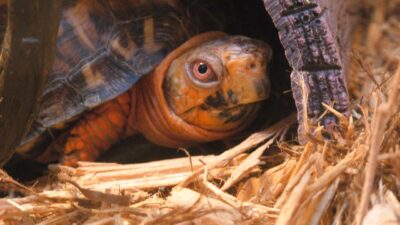Ever wondered if box turtles hit the snooze button and take a winter nap? Well, you’re in for a treat as we explore the question: do box turtles hibernate? These little armored buddies have some fascinating tricks up their shells when it comes to facing the colder months.
Keep reading as we’re about to uncover the mystery behind box turtle hibernation and discover how these resilient reptiles tackle the chilly season with their own unique flair.
Do box turtles hibernate?

Yes, box turtles are known to hibernate. Hibernation is a state of inactivity and metabolic depression that helps animals conserve energy during the colder months when food is scarce. Box turtles, including the Eastern box turtle (Terrapene carolina carolina) and other species, typically hibernate in the wild.
During hibernation, box turtles find a secure and sheltered location, such as a burrow or a pile of leaves, where they can remain dormant. The exact timing and duration of hibernation can vary based on factors like geographic location, local climate, and individual health. In some regions, box turtles may start their hibernation in late fall and emerge in early spring.
It’s important to note that if you have a box turtle as a pet, it’s crucial to provide appropriate conditions for hibernation if it is part of their natural behavior in your region.
However, not all box turtles kept as pets need to hibernate, and the decision to hibernate should be made based on factors like the turtle’s health, age, and specific needs.
Therefore, if you have a pet box turtle and are unsure about hibernation, it’s advisable to consult with a veterinarian experienced in reptile care.
Box Turtle Habitat and Behavior
Box turtles are fascinating reptiles with specific habitat requirements and interesting behaviors. Here are some key aspects of box turtle habitat and behavior:
Habitat:
- Terrestrial Environment:
- Box turtles are terrestrial, meaning they spend most of their time on land. They are adapted to a variety of habitats, including woodlands, grasslands, and meadows.
- Moisture Requirements:
- Box turtles need access to water for drinking and soaking. Maintaining a humid environment is important, but they also require a dry area where they can retreat.
- Hiding Places:
- Box turtles like to hide and burrow. Providing hiding spots, such as logs, rocks, and vegetation, helps them feel secure.
- Substrate:
- A substrate with a mix of soil, leaf litter, and other organic matter is suitable. This allows them to dig and bury themselves, especially during hibernation.
- Sunlight and Shade:
- Box turtles benefit from exposure to sunlight for the synthesis of vitamin D, but they also need shaded areas to regulate their body temperature.
Behavior:
- Territorial Behavior:
- Box turtles can be territorial, especially males. They may establish home ranges and defend them against other turtles.
- Hibernation:
- In regions with colder climates, box turtles hibernate during the winter months. They dig burrows or find natural shelters to endure the colder temperatures.
- Foraging and Diet:
- Box turtles are omnivores, feeding on a variety of foods, including insects, earthworms, fruits, vegetables, and mushrooms. They actively forage for food.
- Mating:
- During the mating season, males may engage in courtship behaviors, including head bobbing and circling. Female box turtles typically lay eggs in a nest they dig in the ground.
- Activity Patterns:
- Box turtles are crepuscular, meaning they are most active during dawn and dusk. During the hottest parts of the day, they may seek shade or burrow into the substrate.
- Longevity:
- Box turtles are known for their longevity, with some individuals living for several decades in captivity. Their lifespan in the wild is influenced by factors such as predation, habitat quality, and human impact.
Caution with Pet Box Turtles:
If you have a box turtle as a pet, it’s crucial to recreate a habitat that mimics their natural environment as closely as possible. Additionally, make sure to provide a well-balanced diet, access to clean water, and veterinary care when needed.
Always be aware of the legal and ethical considerations of keeping box turtles as pets, as some species may be protected by conservation laws.
Behavioral patterns leading up to hibernation
As box turtles prepare for hibernation, their behavior undergoes specific changes. Here are some common behavioral patterns leading up to hibernation:
- Reduced Activity:
-
- As temperatures drop in the fall, box turtles begin to reduce their activity levels. They may become less active during the day and spend more time resting or hiding.
- Appetite Reduction:
-
- Box turtles often experience a decrease in appetite as hibernation approaches. This reduction in food intake is a natural part of their preparation for the period of dormancy.
- Exploration of the Environment:
-
- Box turtles may engage in more extensive exploration of their environment as they seek out suitable hibernation sites. They might investigate various hiding spots and burrows.
- Body Weight Increase:
-
- In preparation for hibernation, box turtles may increase their body weight by consuming more food. This extra weight serves as a source of energy during the hibernation period when they do not eat.
- Basking Behavior:
-
- Before hibernation, box turtles may engage in extended basking sessions to absorb as much sunlight as possible. Sunlight is essential for thermoregulation and for storing energy.
- Burrow Preparation:
-
- Box turtles are known to dig shallow burrows or find existing natural shelters in which they can hibernate. The process of burrow preparation may involve digging, rearranging substrate, and creating a suitable microenvironment.
- Increased Resting Time:
-
- In the weeks leading up to hibernation, box turtles may spend more time resting and conserving energy. This behavior helps them slow down their metabolic processes in preparation for the dormant phase.
- Orientation Toward South:
-
- Some studies suggest that box turtles exhibit a preference for orienting themselves southward in the period leading up to hibernation. This behavior is thought to help them position themselves to receive optimal sunlight.
Factors influencing hibernation in box turtles

Hibernation, also known as brumation in reptiles, is a period of inactivity and slowed metabolism that some animals, including box turtles, undergo during colder months.
Several factors influence hibernation in box turtles:
- Temperature: Box turtles are ectothermic, meaning their body temperature is dependent on external environmental temperatures. As temperatures drop, box turtles may enter a state of reduced activity, eventually leading to hibernation. The specific temperature range and duration required for hibernation can vary among different species of box turtles.
- Daylight Length: Changes in day length can trigger physiological responses in turtles, influencing their behavior and metabolism. Shorter daylight periods in the fall may signal to box turtles that winter is approaching, prompting them to prepare for hibernation.
- Food Availability: Box turtles tend to reduce their food intake as temperatures drop. A decrease in food availability and the turtle’s reduced metabolic rate contribute to the initiation of hibernation. Box turtles may also eat more in the fall to store energy reserves before entering hibernation.
- Hydration: Box turtles need to be adequately hydrated before entering hibernation. They may drink more water in preparation for hibernation, and dehydration during this period can be detrimental to their health.
- Health and Body Condition: Turtles in good health and optimal body condition are more likely to survive hibernation successfully. Sick or weakened turtles may have difficulty entering or surviving hibernation, making their overall health an important factor.
- Burrow Selection: Box turtles often hibernate in burrows or other sheltered locations to protect themselves from extreme temperatures and predators. The availability and suitability of these hibernation sites can influence when and where box turtles enter hibernation.
- Genetics: Different species and even individual turtles within a species may have genetic variations that affect their hibernation behavior. Some turtles may be more predisposed to enter hibernation at specific times or under certain conditions.
- Previous Experience: Turtles may rely on learned behavior from previous experiences. If a turtle has successfully hibernated in a specific location and conditions in the past, it may be more likely to choose a similar hibernation site in subsequent years.
Understanding these factors is crucial for those caring for box turtles in captivity, as mimicking natural hibernation conditions is essential for their well-being.
It’s important to note that box turtles are protected in many areas, and it is illegal to collect them from the wild without proper permits. If you are considering caring for a box turtle, it’s advisable to consult with a veterinarian or a reptile expert to ensure proper husbandry practices, including hibernation management.
When Do Box Turtles Hibernate?
The timing of hibernation, also known as brumation in reptiles, for box turtles can vary based on factors such as species, geographic location, and local climate conditions. In the wild, box turtles typically enter hibernation in response to seasonal changes, particularly decreasing temperatures and reduced daylight hours.
Here are some general guidelines:
- Fall Season: Box turtles usually begin to show signs of reduced activity and start preparing for hibernation in the fall. The exact timing can depend on local climate conditions, but it often occurs when daytime temperatures begin to drop.
- Temperature Drop: Box turtles are ectothermic, meaning their body temperature is influenced by the environment. As temperatures decrease, especially at night, box turtles may become less active and seek out suitable hibernation sites.
- Daylight Length: Changes in daylight length can be a trigger for hibernation. As days become shorter in the fall, it signals to box turtles that winter is approaching, prompting them to enter a state of reduced activity.
- Food Availability: Box turtles typically reduce their food intake as temperatures drop. In the wild, they may forage less and focus on finding a suitable hibernation site.
Where Do Box Turtles Hibernate?
Box turtles typically hibernate in burrows or other sheltered locations during the winter months. The specific location can vary based on the turtle’s geographic range, local climate, and habitat.
Here are some general characteristics of box turtle hibernation:
- Burrows: Box turtles are known to burrow into the ground to hibernate. They dig burrows in well-drained, sandy, or loose soil. These burrows provide insulation from extreme temperatures and protect them from predators.
- Leaf litter: In some cases, box turtles may choose to hibernate under a layer of leaf litter or other vegetation on the forest floor. The leaf litter helps insulate them and provides a natural cover.
- Logs and debris: Fallen logs, piles of debris, or other natural cover can also serve as hibernation sites for box turtles. They may seek out these areas for shelter during the winter.
- Shallow depressions: In certain cases, box turtles may hibernate in shallow depressions in the ground, especially if the soil provides adequate protection and insulation.
It’s important to note that box turtles are ectothermic, meaning their body temperature is influenced by the external environment. During hibernation, their metabolic rate slows down, and they enter a state of reduced activity to conserve energy. Hibernation is crucial for their survival, as it allows them to endure harsh weather conditions when food may be scarce.
If you’re interested in the specific hibernation habits of box turtles in a particular region, it’s advisable to consult local wildlife experts, herpetologists, or conservation organizations who may have more detailed information based on the local climate and habitat conditions.
Signs of healthy hibernation

During hibernation, box turtles exhibit specific signs that indicate they are experiencing a healthy and normal period of dormancy.
Here are some signs of a box turtle in healthy hibernation:
- Stable Body Temperature: A healthy hibernating box turtle will maintain a stable body temperature. While in torpor, their metabolism slows down, and their body temperature drops to match the surrounding environment. It’s essential that the temperature remains within a safe range for the species.
- Slow Breathing and Heart Rate: The turtle’s respiratory and heart rates significantly decrease during hibernation. This is a normal part of their physiological response to conserve energy.
- Consistent Weight Loss: Some weight loss during hibernation is normal for box turtles. They utilize stored fat reserves to sustain themselves during this period of reduced activity.
- Lack of Response to Stimuli: A hibernating box turtle will show minimal responsiveness to external stimuli. They may not respond to touch, sound, or other disturbances. This lack of response is a protective mechanism to conserve energy.
- Intact Shell and Limbs: A healthy hibernating box turtle will have an intact shell and limbs. Any injuries or abnormalities observed during hibernation may indicate health issues or problems with the hibernation environment.
- Normal Post-Hibernation Behavior: After hibernation, a healthy box turtle will gradually become more active. They may show an increased interest in food, bask in sunlight to raise their body temperature, and resume normal behaviors associated with an active state.
Box Turtle Hibernation vs. Brumation
Box turtles, like many reptiles, undergo a period of dormancy during the colder months. The terms “hibernation” and “brumation” are often used interchangeably, but they can have slightly different meanings depending on the specific characteristics of the animal and its metabolic processes.
- Hibernation:
- Generally associated with warm-blooded animals, such as mammals.
- During hibernation, the animal enters a state of prolonged torpor with a significant drop in body temperature, heart rate, and metabolic activity.
- Hibernation is often triggered by a decrease in environmental temperatures and a reduction in food availability.
- Animals in hibernation are less responsive to external stimuli, and their metabolic processes are nearly shut down.
- Brumation:
-
- More commonly used for cold-blooded animals, including reptiles like box turtles.
- Brumation is a form of dormancy specific to ectothermic (cold-blooded) animals, and it involves a slowing down of metabolic processes in response to colder temperatures.
- Unlike hibernation, brumation doesn’t typically involve a dramatic drop in body temperature. Instead, the animal’s temperature decreases to some extent, but it generally remains above freezing.
- Reptiles in brumation may still be somewhat responsive to stimuli, and their metabolic rate is reduced but not as drastically as during hibernation.
For box turtles specifically:
- Hibernation: The term “hibernation” is often used when discussing the dormant state of box turtles, even though they are ectothermic. Box turtles do experience a significant reduction in activity, metabolic rate, and responsiveness during the colder months.
- Brumation: Some herpetologists and reptile enthusiasts may use the term “brumation” to emphasize the fact that box turtles, being cold-blooded, don’t experience the same extreme drop in body temperature as mammals during dormancy.
In practice, the distinction between hibernation and brumation in reptiles might not always be rigidly applied, and the choice of terminology can vary among researchers and hobbyists.
The key takeaway is that box turtles undergo a period of reduced activity and metabolic slowdown during colder months, adapting to their ectothermic nature and the seasonal changes in their environment.
Conclusion
If you are on the search for answers to the question do box turtles hibernate, then we have got you covered. Box turtles do undergo a form of dormancy known as hibernation. During this period, they experience a significant reduction in activity, metabolic rate, and responsiveness.

